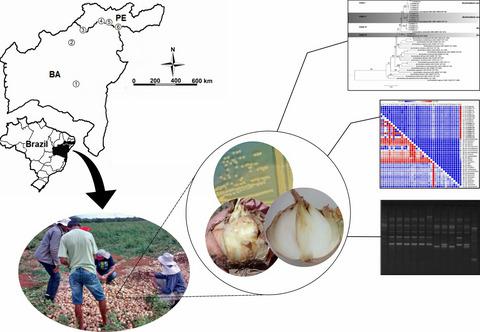当前位置:
X-MOL 学术
›
Plant Pathol.
›
论文详情
Our official English website, www.x-mol.net, welcomes your
feedback! (Note: you will need to create a separate account there.)
Predominance of Burkholderia cenocepacia lineages causing onion sour skin in the semi‐arid region of north‐east Brazil
Plant Pathology ( IF 2.3 ) Pub Date : 2020-11-06 , DOI: 10.1111/ppa.13311 Ana D. B. Baia 1 , Adriano M. F. Silva 2 , Bárbara G. Ribeiro 1 , Claudeana C. Souza 1 , Wilson J. Silva Júnior 3 , Valdir Q. Balbino 3 , Carla M. Leal 4 , Antônio R. G. Farias 1 , Elineide B. Souza 5 , Marco A. S. Gama 1
Plant Pathology ( IF 2.3 ) Pub Date : 2020-11-06 , DOI: 10.1111/ppa.13311 Ana D. B. Baia 1 , Adriano M. F. Silva 2 , Bárbara G. Ribeiro 1 , Claudeana C. Souza 1 , Wilson J. Silva Júnior 3 , Valdir Q. Balbino 3 , Carla M. Leal 4 , Antônio R. G. Farias 1 , Elineide B. Souza 5 , Marco A. S. Gama 1
Affiliation

|
Burkholderia cepacia was originally described as the causal agent of onion sour skin. However, this bacterium is now recognized as a complex of 22 closely related species, commonly referred to as the B. cepacia complex (BCC). Only a few taxonomic studies have been undertaken with the aim of understanding the diversity of species associated with onion sour skin. In this study, we used a polyphasic analysis including rep‐PCR assay, biochemical and pathological profiles, and multilocus sequence analysis (MLSA) to characterize the BCC species associated with onion sour skin in the semi‐arid region of north‐east Brazil. Phylogenetic analysis of the recA of strains representing the genetic variability, as determined by rep‐PCR, grouped the strains into four clades. Clades I and II represent B. cenocepacia lineages IIB and IIIA, respectively, while the strains in Clades III and IV clustered more closely to Clades I and II than to strains of any other BCC species. MLSA confirmed the existence of the four clades with a 1.00 posterior probability. A distance matrix indicated a low level of divergence among the strains of the four clades found in the MLSA, proving that B. cenocepacia lineages IIIA, IIIB, and a new lineage of B. cenocepacia are associated with onion sour skin in the semi‐arid region of north‐east Brazil. Also, surprisingly, no strain was identified as B. cepacia, indicating that this species probably does not play a role in this disease in this region.
中文翻译:

在巴西东北部半干旱地区,洋葱伯克霍尔德菌的主要优势是洋葱皮发酸
洋葱伯克霍尔德菌最初被描述为洋葱酸皮肤的病因。然而,这种细菌是目前公认的复合物的22个密切相关的物种,通常被称为乙。洋葱混合物(BCC)。为了了解与洋葱酸皮有关的物种的多样性,仅进行了一些分类学研究。在这项研究中,我们使用了包括rep-PCR分析,生化和病理学特征以及多基因座序列分析(MLSA)的多相分析来表征与巴西东北半干旱地区洋葱酸皮有关的BCC物种。recA的系统发育分析通过rep-PCR确定的代表遗传变异的菌株的分类将菌株分为四个进化枝。分支I和II代表乙。新洋葱伯克霍尔德杆菌谱系分别IIB和IIIA族,而在进化枝III和IV的菌株集群更紧密地进化枝I和II不是任何其他BCC种的菌株。MLSA以1.00的后验概率证实了这四个进化枝的存在。的距离矩阵所示的四个分支的菌株中发散的低水平在MLSA发现,证明了乙。新洋葱伯克霍尔德杆菌谱系ⅢA,ⅢB,和一个新的谱系乙。先验与巴西东北部半干旱地区的洋葱酸皮有关。此外,出人意料的是,没有菌株鉴定为乙。洋葱,表明该物种可能不在该地区的这种疾病中起作用。
更新日期:2020-11-06
中文翻译:

在巴西东北部半干旱地区,洋葱伯克霍尔德菌的主要优势是洋葱皮发酸
洋葱伯克霍尔德菌最初被描述为洋葱酸皮肤的病因。然而,这种细菌是目前公认的复合物的22个密切相关的物种,通常被称为乙。洋葱混合物(BCC)。为了了解与洋葱酸皮有关的物种的多样性,仅进行了一些分类学研究。在这项研究中,我们使用了包括rep-PCR分析,生化和病理学特征以及多基因座序列分析(MLSA)的多相分析来表征与巴西东北半干旱地区洋葱酸皮有关的BCC物种。recA的系统发育分析通过rep-PCR确定的代表遗传变异的菌株的分类将菌株分为四个进化枝。分支I和II代表乙。新洋葱伯克霍尔德杆菌谱系分别IIB和IIIA族,而在进化枝III和IV的菌株集群更紧密地进化枝I和II不是任何其他BCC种的菌株。MLSA以1.00的后验概率证实了这四个进化枝的存在。的距离矩阵所示的四个分支的菌株中发散的低水平在MLSA发现,证明了乙。新洋葱伯克霍尔德杆菌谱系ⅢA,ⅢB,和一个新的谱系乙。先验与巴西东北部半干旱地区的洋葱酸皮有关。此外,出人意料的是,没有菌株鉴定为乙。洋葱,表明该物种可能不在该地区的这种疾病中起作用。











































 京公网安备 11010802027423号
京公网安备 11010802027423号